So it's been almost a year since I've blogged. It's not that I stopped caring about being an artist or any such thing: I became pregnant. I found pregnancy to be really challenging and I lost a lot of focus. Then I had to move back up to Canada because I couldn't afford insurance in the States. So I stayed in Vancouver with my parents while my husband (and studio) were in Portland. Then the baby arrived almost 2 months early (hello there!) and I've been focused on that.
I absolutely love being a mama. My baby is amazing and I have so much fun with him. It's just incredible to watch him develop. And to be honest, I've wanted a baby for a long time and it's better than I expected. So I am very, very lucky.
I am, however, not finding myself to be cut out for long term stay-at-home momness. My entire existence just can't revolve around my son. So I find myself returning to art. This is more difficult than I expected, as my schedule is subject to the whims of a five-month-old. It's also a bit my fault, because I refuse to supplement with formula yet haven't been pumping, can't focus with my little guy around, and freak if another caretaker (including his father) takes him out of my sight for more than an hour.
Perfect opportunity to work on the business side of things a bit more. I can type or read with one hand while I have boy on the boob. My in-laws gave me a great book called Art Business Strategies. It's put out by my beloved Interweave Press and is aimed at art quilters. I don't quilt but I haven't come across anything that's not applicable to surface designers. It also seems to be the best book on the subject that I have found yet. I'm beyond pleased.
The chapter I am looking at now is about setting goals. It's important to choose goals that you have control over. "I'm going to get into that juried art show" is not an appropriate goal because you don't have control over how the jury picks submissions. "I'm going to submit an excellent quality submission to a juried art show" is more reasonable because you are totally in control and can focus on the quality of your work, good photography, making the submission deadline, compatibility between the show and your work, etc.
So my goals this year are:
1. Get an Etsy shop up, running, and maintained. I will be closing my iCraft shop because I haven't made a single sale, even when I did all the extra work that they say you should. It just doesn't get enough attention for a beginner seller.
2. Enter into galleries/shows. Maybe I can aim for one submission a month at this point. Be really anal about it.
3. Develop a professional website. This one is great for documenting my educational journey, but it's not professional.
I think these are good goals for now. I'd rather keep my goals modest at this point and adjust them when I need more of a challenge. The wee one keeps me pretty busy and insisting that I do this full time immediately won't work!
I am back to school this week.
School is never really over when you're self-taught, so I have been watching some Art:21 broadcasts, which are wonderful. There have been a number of them that I've watched and so I can't give all the details, but it's amazing to see artists at work, with assistance and big shows at museums. It reminds me to keep at it and that it is possible to make your living at art. I like the energy of a lot of the artists, who just get an idea and then explore it until they are satisfied.
I was in my first Portland craft fair this weekend. I didn't sell much but I got some other things out of it. For one, I was invited to submit work to their consignment shop. I met someone who I might do a show with when my series is ready. I got a lot of positive feedback on my work. Also, a good portion of my Portland friends were able to make it out and support me. I won't be able to do the next one mid January, but I was told that things pick up for February because of Valentine's day. So I am going to try to make sets for two to sell there and at my online store.
I took a class on feather earring making this Friday. It wasn't difficult at all, and it was lots of fun! If I didn't already know that I wanted to do surface design for a living I might make feather earrings, although a lot of people are making them right now. Anyways, it was nice to make a couple of pairs for myself and I got supplies to make one more pair. I need to remember to make stuff that doesn't have anything to do with my work sometimes. It makes me feel a lot better.
I am still working on my three large commissions. They sure take a long time! In the future I will charge more for them, as they are a little trickier than if they were small pieces. But I am happy that I have these ones.
I've written up my new lesson plan under that section of my blog. Check it out! Also, I'm going to go reserve the drawing book from the library.
I had a number of learning experiences this last week, although none to show you pictorally at this time. First, I applied for one of the local craft fairs. I have yet to hear if I have gotten in, but it seems like a good fit and is an affordable place to start building my craft fair presence. It's called Crafty Underdog and it's a bimonthly event at a local theatre-restaurant. It sounds like a lot of fun, and my husband and I are going to attend the next one to see what it's all about and who's selling what. While researching craft fairs, I came across this post on one of my favorite blogs which included a PDF of tips for sellers who hate selling. I'm not very good at sales, despite several years of retail experience. The PDF is so immensely helpful. It even includes questions you can ask your booth visitors to start a conversation rolling without being an aggressive salesperson. All I can say is THANK YOU THANK YOU THANK YOU! I tend to slouch behind my booth with a frightened look on my face, which isn't terribly inviting. They had suggestions like standing in front of your booth. It has made me so happy. Even if I don't get into Crafty Underdog, it's very useful for other craft fairs I might get into. I also came across this article via Facebook. It's about the many hats that a performing artist must wear, and is an answer to the question of "do you just do this or do you have a job?" As I am discovering, being and artist, performing or otherwise, involves many jobs, not just making stuff. So in addition to the actual production of art, I am a marketer, agent, seller, social media coordinator, administrative assistant, accountant, business manager, PR person, delivery girl, website designer, photographer, graphic designer, and hopefully soon, a teacher. So that's 14 jobs. On top of that I volunteer at the museum, educate myself in art (as well as all the other jobs that I don't have much experience in), try to live as self-sufficient a life as possible (made my own toothpaste today), go to church, edit my husband's manuscripts, and spend some quality time with my husband and friends. I try to squeeze a little exercise in there as well as it makes me feel much better. I am hoping to add more volunteering too: I'd like to get involved in some kind of feeding-the-hungry project, and I'd like to teach Sunday School. But I am not going to go hog-wild trying to add everything at once or it will make me crazy. I should also point out that I have a friend helping me with ad copy on my online store and my husband helps me with the social media. Nevertheless, I am extremely busy. So when people ask me when I'm going to get a job (because people do ask me that) I can tell them that I have 14 and don't have time to take on any more right now. I had a good time volunteering at the Museum on Thursday. It was pretty slow, which was kind of boring, but it's also a great environment because everyone is an artist and everyone is interested in everyone else's work. So although I did it to learn about how a museum is run, I actually am doing a fair bit of networking and promoting my business. Totally not what I expected! I also got a bit of time to look at the exhibits. I never have enough time on shift to spend the hour and a half you really need to look at everything, but I can get things in bits and pieces. After my shift, I went to a lecture by the artist Kanishka Raja. I really enjoyed looking at his paintings and his influences (he does incredibly detailed paintings which sort of reference surrealism and magical realism). However, his talk used what I call "Academicese" which is language that is so highly peppered with field-specific jargon that it is unintelligible to anyone outside the field. There was talk about mitigating the interstices between modality and ornamentation and such. So I have a good idea of what his art looks like and no idea about anything he said. It was worth it to see the art, however. I listened to a couple of podcasts from Art Biz Blog. The first one that I listened to was about gratitude, which is lovely (it was her last podcast, so she was thanking her listeners. One thing I did get out of it was the That Is Priceless blog, which takes famous works of art and gives them new titles. It's hilarious. The second one was about how to get free stuff for marketing information--mostly advertising the blog itself. The last and most helpful one I listened to was about people who did all their art marketing without the help of the internet. One person did her sales through a mailing list sent out to friends and family. She sold shares in her research trip to China and financed it that way. The local newspaper heard about it and she sold even more shares. Another artist sold hundreds of paintings through her mailing lists, displaying things at restaurants and selling at fundraisers. She uses postcards for a personal touch. So those are good ways to get the word out in addition to messing about on the internet!
A few items: I have adjusted prices in the store for Cyber Monday. If you were thinking of getting something, I recommend that you do it now, as I am going to be raising my prices soon. I realized that, even though I was more or less paying myself a little over minimum wage in the studio for the time I worked on my projects, I wasn't paying myself for the time I spend marketing and researching and whatnot. The two take up roughly the same amount of time. So I will be raising my prices to reflect this. I heard about something called the Artists Advent Project in which artists donate a piece of work to the public domain for everyone's enjoyment. I am thinking of what I can donate. There is a small list of things I have to do in order to participate, such as use a certain hashtag in my promotion, choose a copywriting method, and sharing it widely. Advent is a very special time for me so I'd love to participate. More about that soon. I have also discovered (via my husband) about a fantastic website about having an art business called Art Biz Blog. It's got lots of amazing tips, as well as a podcast. I have been neglecting some of my studies lately and I need to get back to it, particularly about business. It's especially good for me because there are tips for introverts like me. I'm not one for hobnobbing, but I can carry business cards with me, and when people ask me what I do, I can give them a business card. Also, social networking is a big sales driver, which is cool. I'm pretty proficient at Facebook but my Twitter skills suck. Maybe that's something I can improve on. Speaking of my husband, I want to plug his blog, Author/Author. He is a fantastic writer and this is his blog about the process, as well as letting readers know about his upcoming work. He is also participating in the Artists Advent Project and is giving away a story. I suggest that you check it out. You're sure to enjoy his work. One more thing: this blog has been accepted into the Fiber Arts Blog Ring. The link is on my home page (I haven't figured out how to add it to this page). I encourage you to check it out and look at the work of other Fiber Artists! Well, I think I've just convinced myself to set up a Twitter account!
Hi all! I am continuing my trend of not much study, more work. Although I should point out that I am learning a lot as I work. I have heard that it takes 10,000 hours of practice to achieve mastery at something, and I can see how that is the case. I am learning so much so fast right now! I'm sure that won't always be the case (learning plateaus for a while, sometimes) but it's been quite a ride so far. I've made a few sales, mostly commissions, and great feedback for my work! I have an announcement: I have opened my online shop! You can find it at icraft.ca/mouse-and-bear. Also, I am already negotiating my first sale! ICraft is sort of like Etsy, but it suits my particular needs better. So far, I only have a few items up but I will be photographing and adding more items soon. So I hope you will come on by and check out my store!
So, I don't know how many people regularly read my blog, but those who do may have noticed that I haven't been posting much lately. That's because I've been having less and less time for school. My business is taking up a lot more time. Instead of doing surface design for an hour every other day, I now have to do it for a few hours every day. Now, according to the unschooling method, this is still school because I am learning things about surface design as I do it professionally, such as how to replicate a color I mixed in a previous batch, how to make new colors, and how to make items thick enough to be serviceable while using a fabric that's thin enough not to be a pain. I am currently working on a batch of napkins and placemats for my brother and sister-in-law, who have requested green and brown for the placemats and yellow and blue for the napkins. Additionally, they want something natural-looking. I have made mistakes and had to start again, run out of supplies, and all kinds of adventures. Also, I'm trying to focus a little more on the business side of things, such as picking up supplies, communicating with future clients about exactly what they want, recording expenses, and arranging deliveries.
Here are some photos of the project, part of the way through:

Pole-wrapped napkins with glue resist drying. The mess you see around them is the typical state of my studio. I can clean it up (clean is a relative term) and it will be this messy again in an hour and a half.
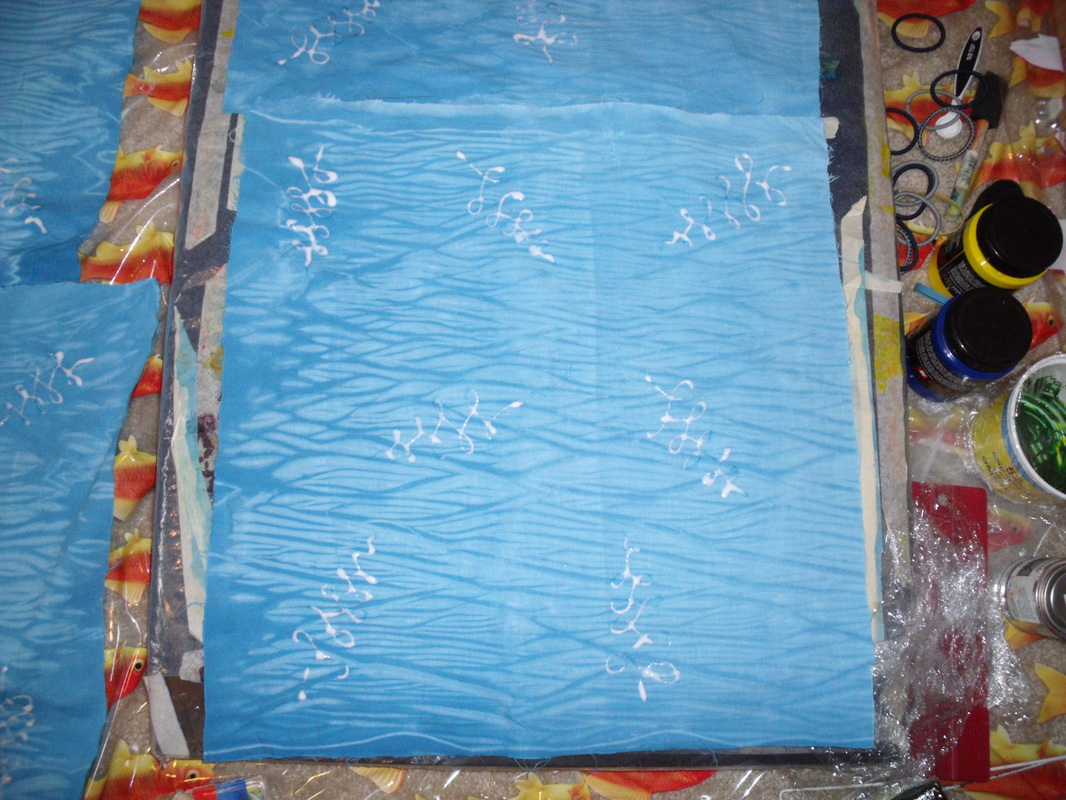
Close-up of the glue resist.
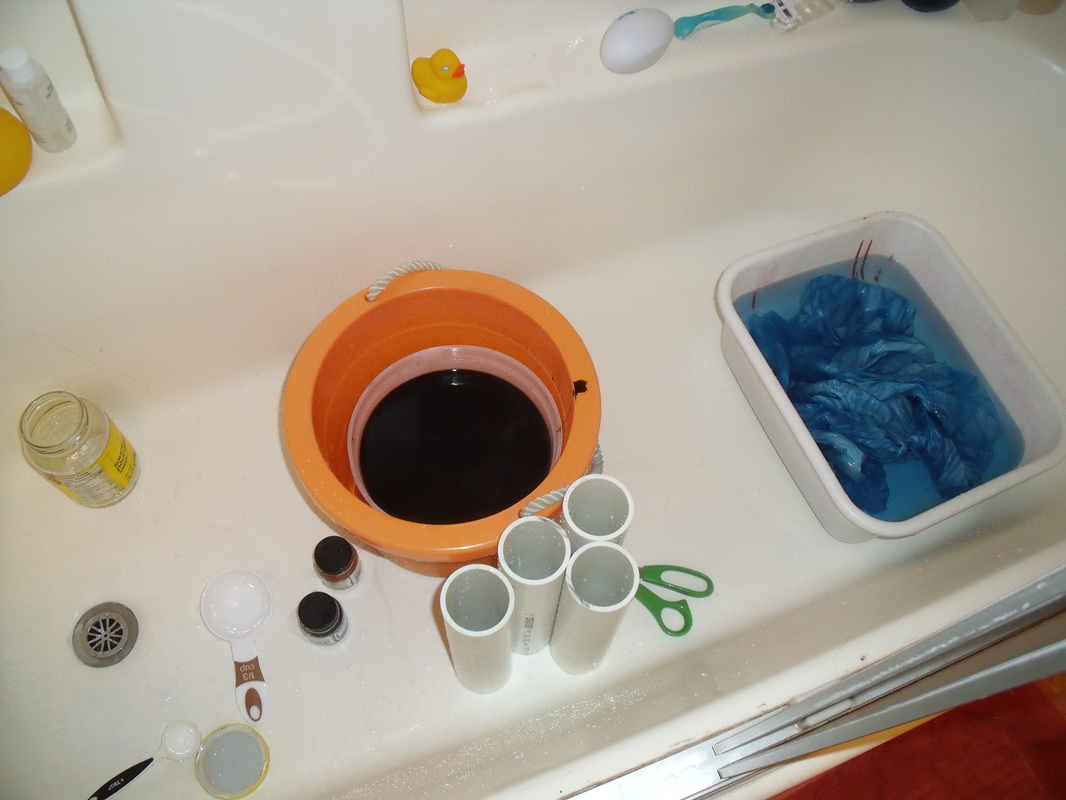
Supplies.
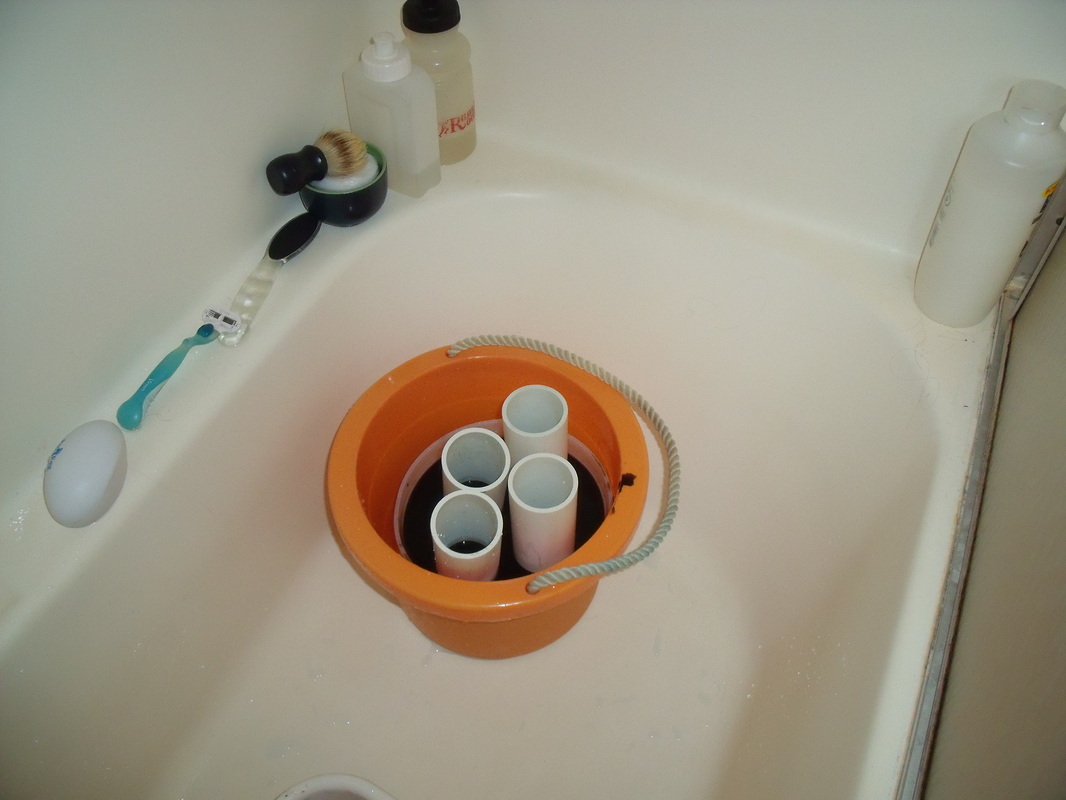
Pole-wrap in action! Most of the immersion dyeing takes place within the bathtub. I try to keep a bucket in the bathroom so that we can throw the supplies in there while we shower.
One day when I'm rich and famous I will have a separate studio outside my living quarters so that the bathroom can be for bathing and the bedrooms can be for sleeping. Or at least for less-messy crafts.
In addition to business, I have added a fair bit of exercise to my routine because I find that my quality of life is so much better if I do. I walk every day anyway, but I have also been adding running, pilates, and yoga. This ends up being between an hour to two hours of exercise a day. My back pain has disappeared, my concentration has improved, and my mood is so much better (doing something I love for a living doesn't hurt either). I don't know if I'll lose weight or develop amazing lung capacity or anything, but that would be nice too.
I am going to be volunteering with the Museum of Contemporary Craft in the Pearl District of downtown Portland. It's my favorite gallery here. I have my volunteer orientation tonight. I'm not sure how often I'll be volunteering, but it will be nice to get out more often and hang with people who love art, while supporting my favorite gallery. My other volunteer thing is that I seem to have become a chaplain with Occupy Portland. I didn't intend to do this, but like most things with the movement, it just kind of happened organically. Really, this is very nice because I got my degree in Religious Studies because I wanted to help the world, and the mainline church hasn't really needed or wanted to use my education. Here are some people who don't care that I haven't gotten my master's degree or gone through discernment committees, they just need some help. So I'm happy to be useful in that way.
Hopefully, I'll have a little more time for school soon and I can keep everyone posted on what I've learned. In the meantime, look out for more progress reports on my business projects!
I sort of did this day over the span of two days. Yesterday was a holiday (Columbus Day in the US and Thanksgiving in Canada) so I only did a little work. Also, I'm having trouble with my productivity lately. I am learning stuff but not at the rate I would like. So I will see if I can ramp things up a bit over the coming week. I listened to two podcasts yesterday. The first one was about a Shibori artist from the UK. She worked primarily with Indigo, but also with iron rust. She does beautiful, intricate shibori work, which leaves me in awe. She takes quite a lot of time very carefully stitching, dipping multiple times in the dye vat, and then carefully undoing the stitching. You can see a little of her work and the kits she sells at http://www.callishibori.co.uk/. The next podcast I listened to was by a textile designer-turned cultural anthropologist who had a little money that would either let her work in her studio for six months or allow her to travel to India to study textiles. She didn't know which one she would rather do, so she flipped a coin. The coin "chose" the trip to India. She has traveled all over India, and has specialized in studying the block printers of the Kutch region in Gujarat. She specifically studied ajrakh printing. She absolutely loves traveling in India and has arranged many exhibits in the West. For business study, I watched some more of the Art of Photography episodes. The episodes I watched were all about developing film. I won't be doing that anytime soon, but it was a fascinating process to watch. The developing fluids were poured into a little light-proof case that held the film. There were three different fluids, but I can't remember what they all were. I wonder if photographers today miss this sort of process, or if they find Photoshop gives them better control. In design, I did a review of the chapter on form, doing sketches as I went. I looked at variety, balance, and dominance. It was a good review to make sure I understood the terms. I will have to give this book back to the library soon so I need to finish my review to make sure I understand all the concepts. Finally, I finished off some bookmarks, as well as a sample of a project that I am doing for my brother and sister-in-law. I worked on a few other items as well, applying the glue resist, stitching embroidery, and the tedious work of ironing everything. I find that working with cloth is half tedium and half creativity. It's a bit like cooking, where you spend half your time creating and half your time cleaning up or doing repetitive chopping or something. When I put on some music and daydream, the tedious stuff is not so bad, and I can get excited that it will lead to creative stuff. Anyways, I took some photos of my finished objects. 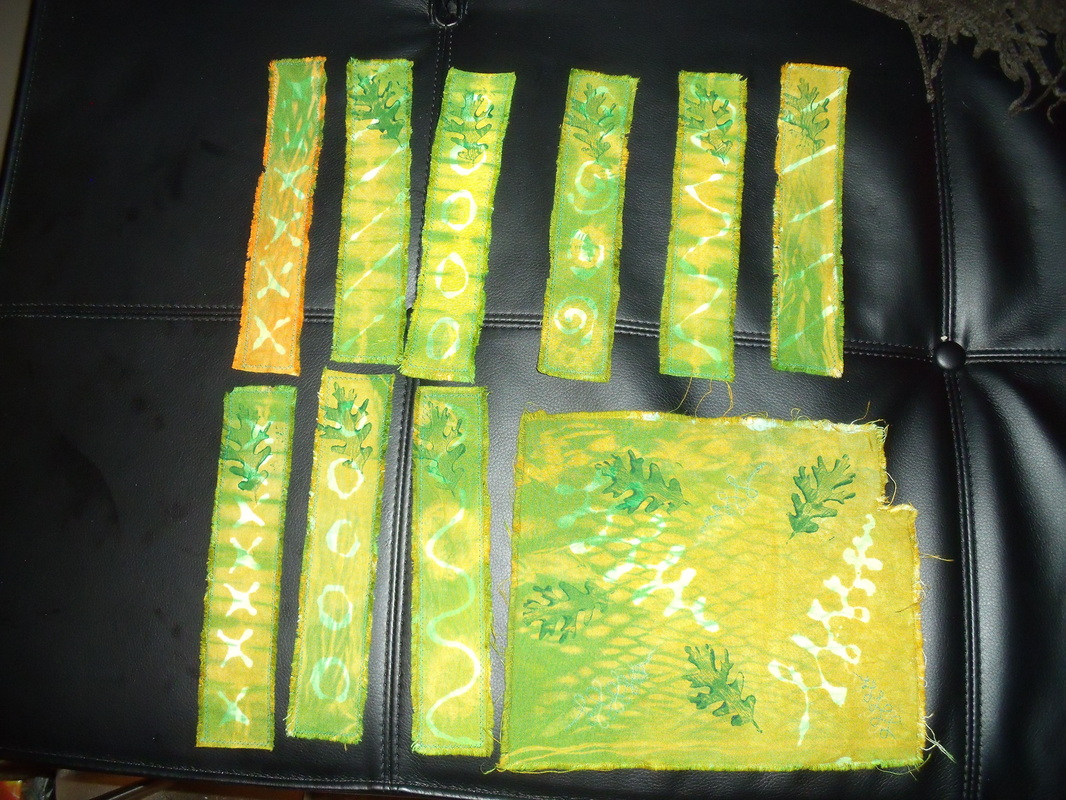 Bookmarks and sample. In the future, I will leave the leaf print off the bookmarks, as I feel that it takes away from rather than adding to the design.  Close-up of sample. Pole wrapped and dyed, glue resisted, overdyed, printed, and machine embroidered.
Yesterday, I had a great experience with my friend Amber. We sort of had a skills-exchange party. Amber showed me some things about sewing and I showed her some things about knitting. We had a great day. I made a pillowcase, which doesn't actually fit any of our pillows. I know how to do it now though. Not difficult at all. From soup to nuts I think it took me under an hour. We also worked on a skirt (just the muslin, I don't intend to wear it). Anyways, I had such problems with the pattern and the book that I think I am going to quit this one and make something else instead. I have another book that the pillow pattern comes from, which might be a better fit for me. Also, Amber left some patterns for me to try, so I'm going to give those a whirl. I hope we can have another skills exchange party again soon!
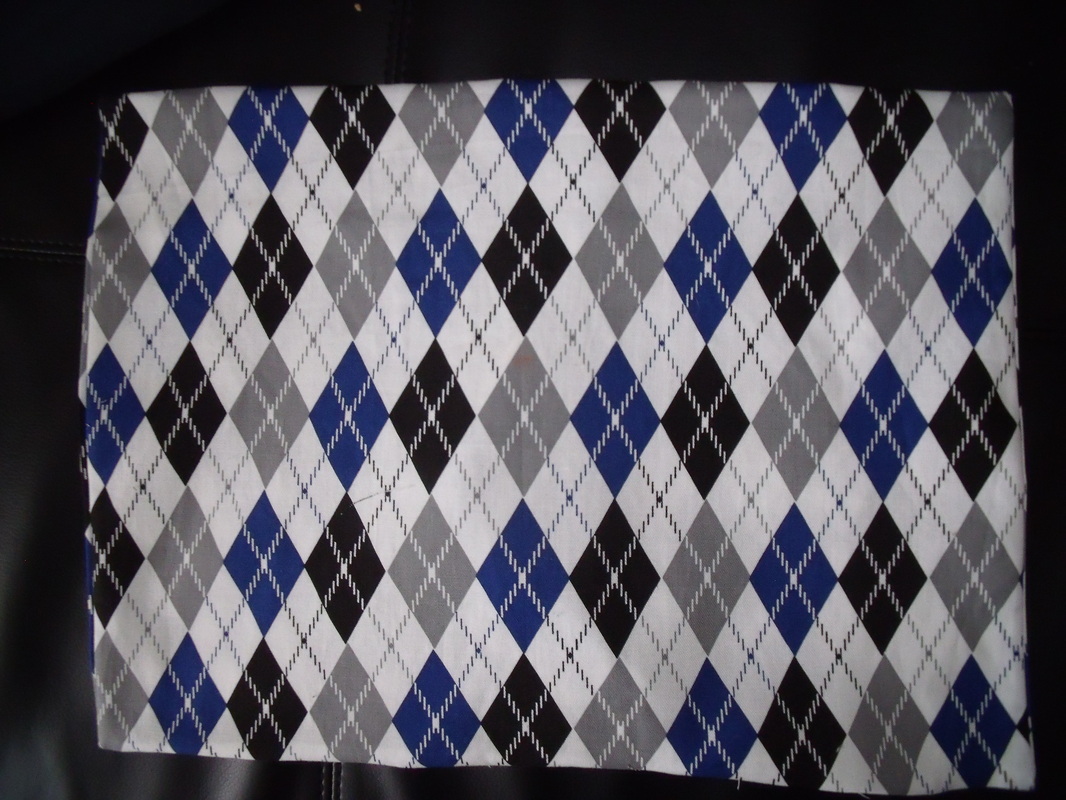
The front of my pillowcase. I like argyle.

The back, with envelope opening showing. That's how you get the pillow in.
For my business study today, I watched four more episodes on The Art of Photography. The first episode was on filters, which are more appropriate for film cameras than digital. With digital, it is more effective to use Photoshop than a filter. The second episode was on metering without a light meter, which involved changing the aperture and the f-stop. I also learned that lots of photographers take slightly darker and lighter photos to make sure that at least one turns out as they had hoped. The third was on a photographer who put together a book called The Americans, and had sort of a photojournalistic style. Finally, the last one was about composition, and there were many elements to it other than the rule of thirds. One thing that stood out was the use of triangles, often creating points with eyes. Most of these triangles were right-angle triangles. Another think I liked was the use of curves in photos, usually on one of the stress points created by the thirds. I finished the last chapter in my design book, and will be going back to invent exercises for each chapter to make sure that I have grasped the concepts. This last chapter was on time and motion. It was a pretty short pattern. Motions on the picture frame are intended to slow down the gaze of the viewer, who will usually try to look at something quickly. Motion can be implied by line direction or shape position. The sequencing of images gave rise to animation and moving pictures. Some artists, such as the Cubists, tried to give the impression of moving around the subject by showing multiple viewpoints. This can be seen in Cezanne's works, where parts of the table don't line up and where some objects are viewed head-on and others are viewed from above. Sometimes images are superimposed or blurred to give the impression of moving around the subject or to suggest motion. Think of cartoons in which the character runs, and his feet turn into multiple feet moving very quickly. The chapter has a short history of moving pictures, which I won't get into here, and also discusses video artists. Additionally, computers and multimedia can be used in art now. Motion can also be implied in three dimensional work, again by showing multiple viewpoints. Additionally, there is kinetic art, which is usually sculpture that actually moves. In dyeing today, I had an interesting experiment: trying to make brown. Theoretically, brown should be dark orange. I don't have black to add to orange (which I can make with red and yellow). What I did was to mix up some golden yellow, which is close to orange, and added a tiny bit of blue and a tinier bit of red. The dye looked pretty brown but it seemed a bit on the orange side when I painted it on. I won't know exactly what the color will be until I've washed out the dye. I am hoping it will be brown, but I can keep mixing if not. I didn't saturate my cloth with dye so I'm hoping I can dye it once more if it's not brown enough.
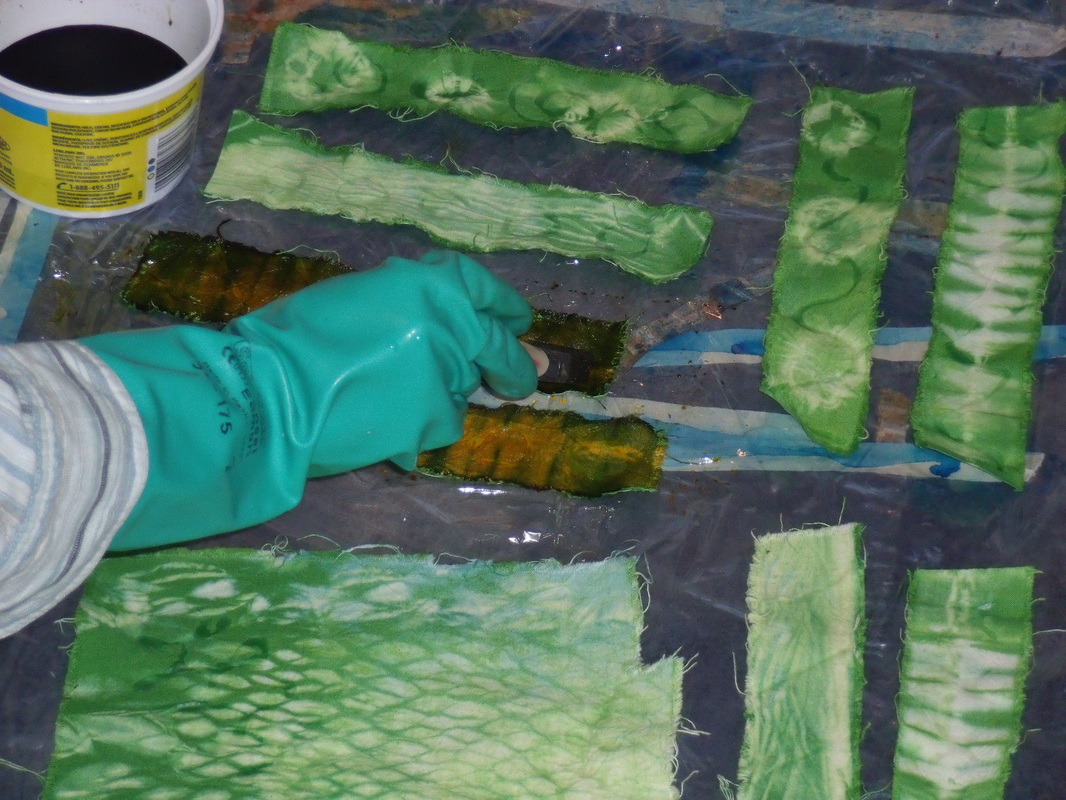
The bottom one turned out very orange. I tweaked it a bit after that.
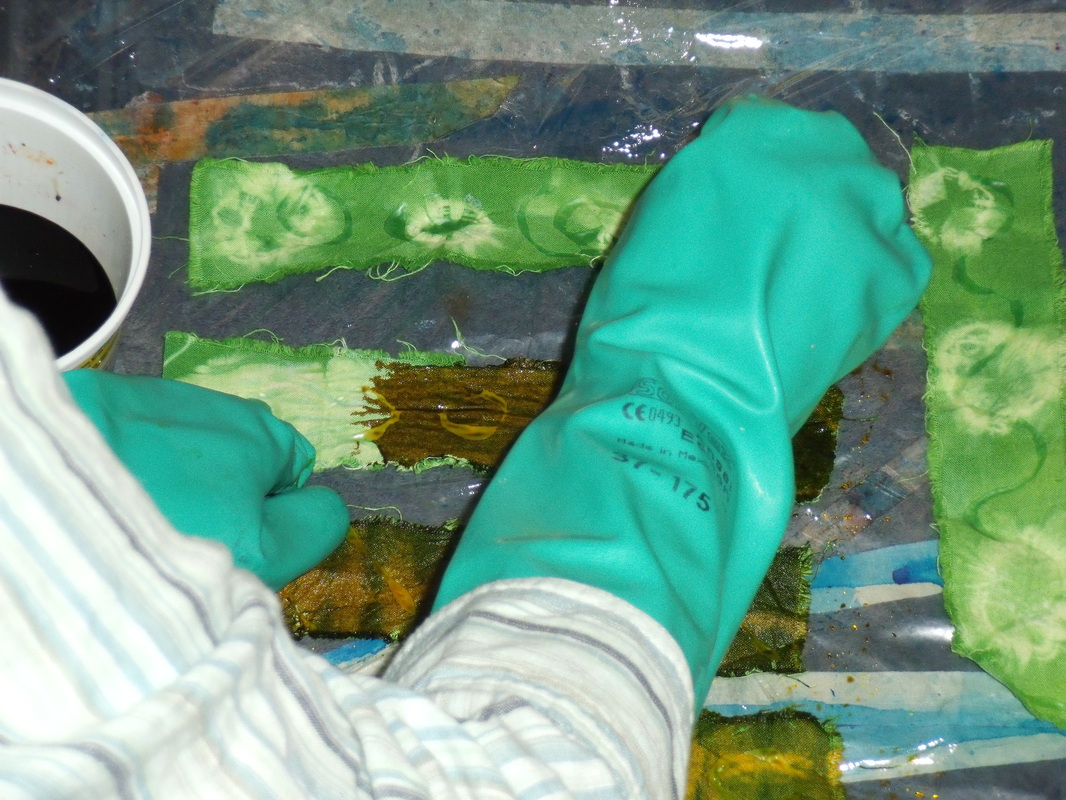
Looking browner, but still a bit orangey on the resist. We will see.
I am back in Portland for the time being, so I have access to all my stuff here. It's really nice to be around my supplies and my husband again. I had a grueling time getting back--what was supposed to be an eight hour trip (by land) became 15 1/2 hours. I spent the next couple of days recovering from that. But I am back in the swing of things now. We have decided that I will spend half my working day in study, and half in production and business. I am also happy to announce that I have made my first large sum of money! This was on the commission I had told you about earlier, for my friend Melanie. Here are the pictures of my work:  Long view. It's a table runner. 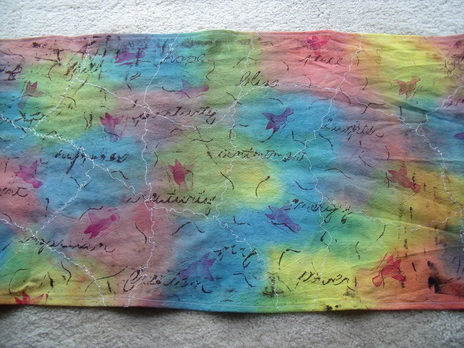 The middle. 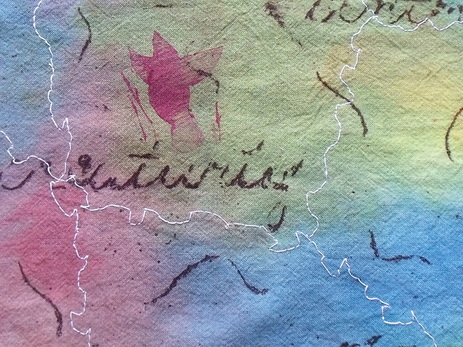 Detail. The table runner was made with a number of steps. First, I had to wash the fabric with a special soap to get all the oils and imperfections out (it was sort of a natural beige when I started). Next, I painted the fabric with liquid dye. I let it rest a couple of days and then rinsed the excess dye out (this process usually takes me about an hour). Then, I pinned the cloth to my work surface and put a flour paste over top. I wrote words and squiggles in the paste with a skewer. I let that dry for a few days and squished the hardened surface to make it crackle. I then applied a thickened dark purple dye over top with a brush, really working the dye into the cracks. After another couple of days I soaked it in warm water to remove the flour paste, and then washed it to remove the excess dye. I had to do this flour paste and dye step four times because my work surface was only so big. Next I carved out a bird stamp with safety cut lino, and used that to print the birds with textile paint. After that dried and 24 hours had passed, I heat set it with an iron. Then I sewed the white stitching on with my sewing machine and a free-motion darning foot. It took me quite a while because I spent as much time unjamming my machine as I did sewing! Then I pulled and pulled on the fabric to straighten it out (it bunched a bit when I embroidered it) and ironed it to make it flatter. Finally, I sewed all the edges so they wouldn't fray. And that, my friends, is what goes into my work! Today I started with a little warm-up. It was very similar to a warm up I had done before, in which I thought about my artistic "DNA" and why I was attracted to surface design in particular. I'm still not sure I can explain--I understand why I am into fiber arts (my mother did it, her mother did it, her mother did it, etc.) but when I tried surface design, it just felt right. It felt like what I was supposed to be doing. I can't really explain it any other way. Next, I listened to two podcast. I had heard them both before. The first one was the second part of the round-table discussion I was listening to earlier. I listened to it on the train originally but I had such an awful day that I forgot it all. It was actually still difficult to remember, because people were mostly talking about what they felt like talking about rather than having an organized topic. There was some discussion on the commercialization of textile traditions, whether it be that a peasant ask for money to be photographed in her traditional costume, or from outside companies who market a traditional craft for a little while until it ceases to be trendy. They talked a bit about going to remote locations to find crafts, and the excitement and danger that could be involved. They talked about the tragedy of collectors buying up all the crafts in one area until there were none left and no one knew how to make them anymore, and how the public sometimes doesn't understand the textiles that they are viewing. One of the panelists had to sell most of her collection of textiles in an auction because she didn't have the space to store them anymore, and not one of the people who bought the work has contacted her to find out about her research on that particular textile. She also collected many pieces for the Victoria and Albert Museum, and by the time she was finished, they were no longer interested. There have, however, been some interest by the national archives, so that is positive. The other podcast I listened to was about a clothing company called Ocelot. I had heard this podcast before but the website had pictures to go with it so I listened again. The podcast explained how the artist got into dyeing and making clothing: she was exposed to dyeing as a child, and got into costume design after college. Eventually, she became fascinated with natural dyeing and clothing construction, and seeks to create clothing that is timeless and beautiful. In her dyeing, she uses wooden blocks as physical resists. You should really check out her work because it's absolutely beautiful. Then, I drew. I drew a bowl. It was a white bowl, but that doesn't really show from the shading I did. Need to work on that shading. I was quite successful with shading in my last drawing, but it was much more difficult to depict a smooth surface. I will have to draw more white ceramic. For surface design, I am trying a glue resist with dye. It worked very well with fabric paint and now I will see how well it works for dye. I also learned how to get dye out of the carpet! Dropcloth it is then. I had loads of leftover dye so I painted dye on one piece of cloth and tried a pleated resist with another. Those will take a day or two to do their thing, so I don't know how they will all turn out yet.
My husband did some research on my behalf to investigate how to reach Canadian customers. I am focusing on Canadians right now due to my immigration status. I don't want to say too much about it, but it is possible that there may be some disruptions in the next few months, which would affect my unschooling and my business. But we don't know for sure yet. My husband also contacted customers for me and arranged deposits and such. I am very excited to have him as my business partner. He is much better at promoting me than I am, and at settling deals!
For production today, I had the rather boring task of cutting out and scouring fabric for bookmarks. I am hoping to make bookmarks an affordable way for people to buy my art. Most of my stuff isn't cheap, and I have friends who don't have a lot of money who would like to partake. I thought this would be a good way, since I can't lower my prices. I just pay myself a little over minimum wage, so I don't listen to any complaints about the prices being too high!
That's it for the day. I'm off to eat dinner and meditate.
I suppose the way to hell is paved with good intentions, and I had the best intentions to study while on my trip. Perhaps not surprisingly, it didn't work out that great. But at least I have done some studying. I listened to a podcast that was the first part of a roundtable discussion of prominent people in the worldwide fiber arts field. There was a woman who was an expert on fibers and the animals who supplied them; another who was the expert on worldwide embroidery; one who had a weaving cooperative; one who ran the store and foundation that supplied these podcasts, as well as doing a million other things to support traditional fiber artists in India; and another fellow whose area of expertise escapes me at the moment. They talked about what it was like to be working travellers: none of them traveled for enjoyment, particularly, or to take a vacation. They all traveled for their work. They were all trying to figure out how to balance intervention in the craft making process. For those who sold traditional work, they tended to encourage people to do the work native to their area, in a high-quality manner. Without these kinds of controls, some craftspeople might do low quality work to sell the craft, leading to its devaluation and the eroding of the skills necessary to produce it. Other craftspeople might be contracted to do work that is not traditional to that region, again leading to the erosion of skill, but also exposing people to the vicissitudes of the worldwide market (that is, if Indian embroiderers are doing Danish style embroidery, and Danish style embroidery goes out of fashion, they will lose their livelihoods. If they do the work that is native to their region, they will always appeal to collectors and those interested in quality regional work.) Some of the panelists were interested in keeping work exactly as it was, never changing. There woman who studied embroidery was dismayed because there was a certain area in India where young women would embroider elaborate pieces for their dowries. Now they embroider pillows for sale. The gentleman whose profession I can't remember pointed out that he had been criticized in India for wanting to "play God", or tell people what they could or could not produce. In the example of the dowry work, he said that many girls no longer bring dowries to the marriage, and if they have such incredible embroidery skills they don't want to use them on something that only their families will see, but on something they could make money on. If they made that money, they could spend it on their children's education and health care for the family and better food. All the presenters said that they don't like interfering, but when crafts are being produced for markets sometimes they have to enforce quality control. Sometimes, these businesses keep the crafts from dying out completely, as the children of many artisans want to be professionals instead. In my design book, I studied the chapter on color. It was a long and technical chapter and I had a lot of trouble with it. It will be difficult to transfer the information to dyes, as dyes have different properties than pigment or light. We see color because of how light reflects off of objects. Colored light is referred to as additive color. The primary additive colors are red, blue (which is close to violet) and green. Combined, they create the additive secondaries of cyan, magenta, and yellow, and when all colors are combined together, they make white. TVs and computers use additive color. Subtractive color is that which comes from pigments. It is called subtractive because pigments absorb some colors from sunlight and reflect others. For example, a green leaf reflects green and absorbs all other colors. There are color systems that drove me crazy. In the triadic color system, the primary colors are yellow, red, and blue. The secondary colors are orange, green, and violet (each one of these sets is a triad) Then there are intermediate colors: red-orange, yellow-orange, yellow-green, blue-green, blue-violet, and red-violet. An intermediate triad would either be yellow-orange, blue-green, and red-violet, or red-orange, yellow-green, and blue-violet. When all these colors are put in order in a circle, they form the 12-point color wheel ( go play with the palette at the bottom of this page). The colors directly opposite each other on the color wheel are known as complimentary colors. For example, the complimentary color of red is green. When a color is mixed with its complement, it grays and creates what is known as a tertiary color. For example, green mixed with a little red creates olive. Tertiary colors can also be created by mixing any two intermediate colors, so long as they are not next to each other on the color wheel (analogous colors). They are found on the inner ring of the color wheel. In the center of the color wheel is complete neutralization, which is a muddy grey. There are also neutrals, not on the color wheel. These are black, which is the absence of color, white, which is all colors, and grays, which are impure whites. Hue refers to the generic color name of the color, i.e. red, blue, green, etc. Colors vary in value, with the highest value color (yellow) at the top of the color wheel and the lowest value (violet) at the bottom. It is difficult to see the relative values just by looking at a picture, and it helps to photocopy the picture in black and white to be able to see the values. You can also lighten or darken hues. By adding white to a hue, you create a tint, and when adding black, you create a shade. Intensity refers to the brightness of a color. A bright red and a grayed red are the same hue, but the bright red has greater intensity. You can also increase the appearance of intensity by putting a color with it's complement, like green with red (maybe that's why Christmastime is so colorful?) Color relationships drove me a bit crazy too. There are complements (opposite on the color wheel), split complements (immediately on either side of the opposite color on the color wheel), triads, which we talked about previously, tetrads, which form a square or a rectangle on the color wheel (for example orange, yellow-green, blue, and red-violet), analogous, which are all the colors next to each other in a small range on the color wheel (say yellow to blue-green), monochromatic colors, which are the same hue but different values, warm colors (reds, oranges, yellows), cool colors (blues, greens, violets), plastic colors (red pops out on a page, blue recedes), simultaneous contrast (colors placed next to each other that make them look different), the emotional impact of color, and psychological impacts of color (i.e. red for anger, green for calm, etc). Color can be used in composition to create contrasts and depth, create mood and emotions, attract attention to something, describe objects, and create aesthetic appeal. In color balance, artists have to find an appropriate balance between harmony and contrast. There is more material in this chapter but I won't go into it, partly because it's about how printing works and I don't think that's applicable to me, and partly because I've been blogging for more than an hour and I'm getting tired! For business study, I read some entries from the Etsy blogs about how to make a living at Etsy. They emphasized good photos (something I have to work on), many product descriptions, and a good shop name. My previous shop name, Penthisilea, isn't great because it's hard to spell (it's actually spelled wrong in my shop) and if you don't know the legend, hard to remember. So I will be choosing a new shop name for my products. Also, banners are important, and you can hire an Etsy seller who does banners to create a better banner for you. They also remind you that photography, site maintenance, and packaging all take time, and this time should be accounted for in the cost of the item. Many people make their living off of Etsy (some even make six figure salaries) so good products and working at it appropriately, I should be able to make my living at it too. No drawing to report for today. Good night!
|














 RSS Feed
RSS Feed
